This was published 1 year ago
Greenland travel guide: The island to end all islands
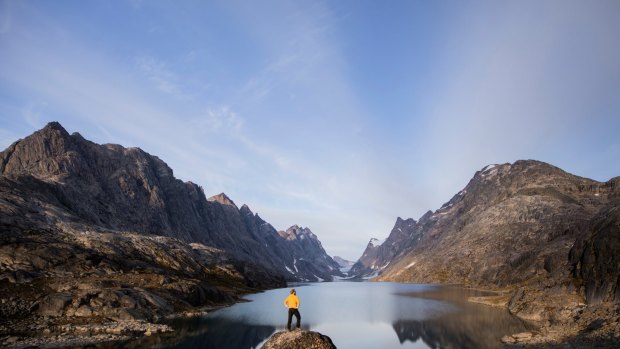
Greenland feels so far away from anywhere else, yet offers so much.Credit: Aningaaq Rosing Carlsen/Visit Greenland
The Zodiac skims across the open water, shattering the glass-like surface of the morning sea. We're sitting on bicycle-style saddle seats and in the frigid morning air the immersion suits we're wearing work their warming magic.
Although the engine of the boat is roaring, it forces us to absorb the surroundings without chatter and provides a strange feeling of calm.
The beauty before us is unreal. Iridescent blue icebergs, differing in shape and size, loom along beside us, their masses gleaming with a vibrant blue hue.
Later at camp, Anika Krogh, our Greenlandic host and Camp Kiattua founder alongside her Danish husband Jon Krogh, explains the iceberg colour is indicative of the amount of air trapped inside.
"Most icebergs are white with just a hint of blue, but the icebergs in this area often appear bluer as they are older and thereby more compressed. With less air trapped in them, the ocean's reflection is stronger."
Smaller chunks of ice don't shimmer that same blue, and I know this because Krogh stopped the boat on the way here to scoop a bunch out for our welcome drinks – signature Kiattua gin and tonics made out of melted Greenlandic icebergs with a twist of house-made angelica and crowberry syrup.
Camp manager Ingimar Igimarsson has jumped back into cheffing for the few days we are here (he was once the chef in charge of the president of Iceland's meals), and every drink and meal he serves is an event.
Located on a remote fjord 1.5 hours by Zodiac from the city of Nuuk, Camp Kiattua by Nomad Greenland – a 2022 World Luxury Travel Awards glamping category winner, for what it's worth – is nothing like the camps I've visited before.
Physically, our camp consists of 10 yellow tepees, each one positioned on a wooden platform that hovers over the Arctic tundra. The cone-shaped tents are designed to fit two people, each one decked out with two beds topped with reindeer-and-sheep-fur Doonas, beautiful local furnishings and gas-powered heaters.
But this camp is much more than a scattering of tents. We spend our days here foraging for crowberries, fishing for cod and Arctic char, and ambling along the plateaus and mountains.
There are 11 of us all up – eight travel agents, two local hosts and me – all travelling together for a couple of weeks. We are a mismatched bunch from all over the world, but we're all here to learn more about Greenland. As I get to know my group, I realise another common thread is our yearning to be challenged through travel.
I opt for a testing uphill hike and waterfall crossing quest with a few others one day. We arrive quite late – and moderately wet – for lunch. As I gulp down the most delicious seafood soup I've ever tasted and swig a glass of wine from Skærsogaard (the first registered and licensed winery in Denmark), the discomfort soon fades.
In Greenland, I discover, you need to prepare for loose plans. The weather is changeable, whales come to the surface when you least expect it, and when the northern lights put on a show, everything else fades into the background.
A few days later, when cruising with Nuuk Water Taxi one night, I spot a minke whale blowing fountains upwards into near-darkness.
Our captain angles a torch to follow the majestic mammal, and I joke that seeing the northern lights would seal the deal. Then, as if he flicked a switch, they make an appearance – bulging swells of emerald green and glowing white unfolding in front of us like a neon sign from the gods.
And that's Greenland for you. A place that feels so very far away from anywhere else, yet it offers so much, and often the unexpected.
It can be tricky to grasp how travel works here because an ice cap barrier renders most of the island uninhabitable. The majority of the population reside beside the coast, and overland travel is limited to a few roads and dogsleds when you journey in from the shoreline.
It's time-consuming to get here and to get around. You can't just hire a car, for instance, and drive because there are no roads between settlements or sights.
Most long-distance trips are by sea or air, and for logistical purposes focusing on one or two geographical regions per trip is recommended.
And it's very probable that weather will change your plans at least once, but sometimes the Plan B adventure is the one that you'll be talking about for years to come.
In Greenland, the unknown is part of the attraction, whichever regions you visit, and, in this following guide, through the eyes of locals, join us on a tour of the island to end all islands.
THE CAPITAL REGION
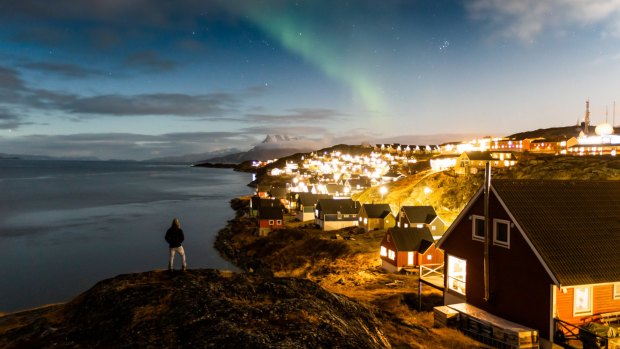
Credit: Matther Littlewood/Visit Greenland
The not so big smoke.
Greenland's capital – Nuuk – is as big as it gets in Greenland. Here you can dine at upmarket restaurants, visit museums, shop local or international, attend concerts, and soak up Arctic city life.
Although it's the economic centre of Greenland, after 10 minutes in a car, you're out among nature. Adam Kjeldsen and Thorlak Nielsen, who launched adventure guiding company Two Ravens in 2018, show visitors exactly that.
"It's pretty special that you can be in town, and that same day be climbing the 440 metre-high Quassussuaq mountain and hardly see a soul," says Kjeldsen. "The fjord system with its majestic mountains and waters truly is spectacular."
For those wanting a slower pace, the smaller communities of Paamiut south of Nuuk and Kapisillit in the Nuuk Fjord offer hiking, fishing, boating and spectacular scenery. Camp Kiattua is located about 30 minutes from Kapisillit via Zodiac.
It's worth noting that works are underway for a new airport in Nuuk that is due to open in 2024. It is one of three airports currently being built in Greenland.
"The new airports will offer easier access to and from Greenland and I'm confident that the number of visitors will increase significantly. There is no doubt that the new airports will be a gamechanger in the development of Greenland as a tourist destination," says Jens Lauridsen, chief executive of the Kalaallit Airports Group.
See nomadgreenland.com; tworavens.gl; visitnuuk.com; watertaxi.gl
NORTH GREENLAND
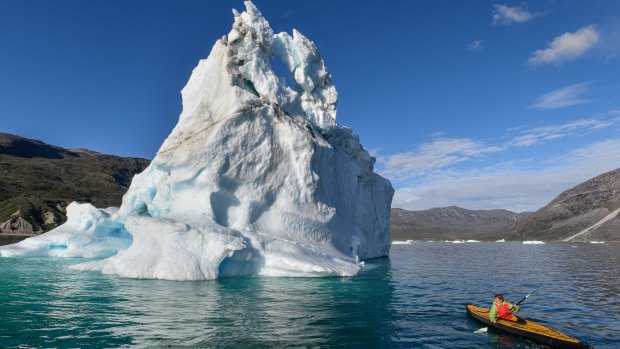
Credit: Stanislas Fautré/Arctic Nomad
Welcome to the iceberg factory.
In this vast and overwhelmingly stunning region, there's always something new around the corner with awe-inspiring kayaking adventures, whale sightings, glimmering icebergs, and picture book-perfect settlements made up of colourful houses that dot the otherwise-stark landscape.
The colourful settlement of Ilulissat in Disko Bay is the gateway to the north (more on that next) and provides access to the five kilometre-wide Eqi Glacier – the fastest iceberg-producing glacier in the world.
Or you could sail a little further to stay at Illmanaq Lodge by World of Greenland, at the time of writing home to Greenland's only Michelin-starred restaurant, Koks, a Faroese fine diner pop-up.
The settlement of Uummannaq is home to the country's northernmost ferry terminal, and the thick sea ice makes it an ideal destination for ice fishing and ice driving. You can also get to know the locals.
The children's home here is one of the world's most northerly care centres for young people, and manager Ann Andreasen has spent over 38 years caring for young ones.
"The children are citizens of the town," she says. "They go to school, and play and participate in everyday life. Visitors are welcome to pop into the centre for a cup of tea."
Most people never get to Qaanaaq – the northernmost town in Greenland – due to logistics and cost. The rewards, however, are incredible. For over three months of the year the sun never makes it above the horizon, and for five months the midnight sun dances in the sky.
There's something magical about a destination that bathes in the extremes of day and night and is visited by so few.
DISKO BAY AND ILLULISSAT
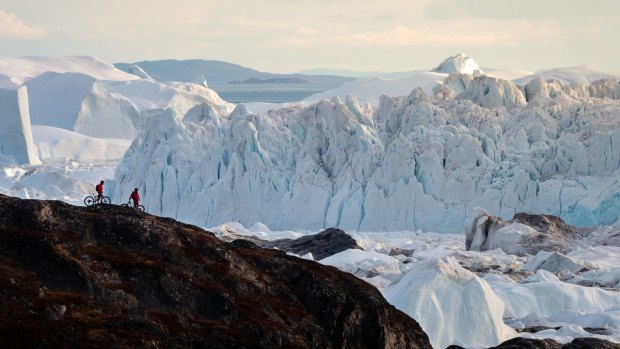
. Credit: Ben Haggar/Visit Greenland
Disko Bay is Greenland's most-visited region, best known for the UNESCO World Heritage-listed Ilulissat Icefjord, its waters studded with massive ice hulks, some so big they tower over the cruise ships that sail by.
During summer, millions of icebergs splinter off the fjord and drift along the water, although in lesser numbers they can be seen bobbing in the sea year-round.
Ilulissat is geographically part of the Disko Bay region, but it's a part of Avannaata Kommunia (a municipality of North Greenland). For visitors, it's just one of Greenland's key tourist destinations, and the awe-inspiring and ever-changing ice display is located just outside of town.
You can take a cruise and spot whales along with the huge icebergs, then watch a cultural show and savour a fine meal in town to end the day on a high note.
Frank Larsen, who runs Diskobay Tours together with Nive Heilmann in Qasigiannguit, says that although summer is the most popular time to visit Disko Bay, every season and experience is magical.
"One of my favourite spots is Saqqarleq Glacier," he says. "To get there, we sail, drive overland and hike, and have a rest standing on an ice sheet drinking ice-melting water."
Then there's Qeqertarsuaq, another place that can't be missed. Greenland's only volcanic region is home to black-sand beaches strewn with ice fragments, intriguingly shaped basalt pillars that bulge out of the water, and valleys that sprout more than half of Greenland's plant species.
See diskobay.gl; diskobay-tours.com
SOUTH GREENLAND
Of bluebells and green grasses.
The southernmost region of Greenland is carpeted in green in the warmer months. Sheep graze on pastures that stretch as far as the eyes can see, and in summer you can even eat fresh vegetables grown by the farmers – a rarity elsewhere in the country.
To soak up local life, why not catch a coastal ferry?
"Sailing plays a very important role in the Greenlandic infrastructure and a ferry trip along the West coast of Greenland is a fabulous way of experiencing this beautiful and varied country, searching for icebergs and whales and watching locals disembark into the arms of their loved ones," says Tietse Stelma, specialist travel company 50 Degrees North co-founder (along with Jayde Kincaid).
"We recommend the Ilulissat to Narsaq segment. The ferry stops at the tiniest of remote villages, with the unloading of critical supplies and mail creating a bustle with each port arrival."
There are no roads or railways that connect destinations in Greenland, but in South Greenland gravel roads weave between some of the settlements, which shortens travel times substantially.
"In South Greenland we have the big glaciers, but we also have sheep farmers and fresh produce in summer, as well as ancient Inuit traditions," says Salik Frederiksen, co-founder of touring company Tasermiut Camp, along with Freddy Christensen.
Tasermiut Fjord (after which the company is named after) is one of Frederiksen's favourite sites. "It's a beautiful area with high-peak mountains and many different lakes, and it's especially stunning in the summer when flowering bluebells embellish green-grassed hillsides and majestic blue icebergs snap off the fjord," he says.
See fiftydegreesnorth.com; tasermiutcamp.gl; visitsouthgreenland.com
ARCTIC CIRCLE
Where musk oxen and reindeer roam.
Australian-born Lisa Germany had been dreaming about visiting Greenland for over 25 years, and after her first visit in 2017, decided to make it her home. Today she works as the content and trails manager for the Qeqqata Municipality and lives in Greenland's second- largest town, Sisimiut.
Germany says the region is special because it offers every Greenlandic experience, but without the threat of polar bears.
"Near Kangerlussuaq, visitors can't miss walking on the Greenland Ice Sheet at Point 660, getting a close-up view of the enormous Russell Glacier, and spotting land-based wildlife such as musk oxen, reindeer, arctic hares and arctic foxes.
Maniitsoq is one of the best places for whale watching and ski touring. And from Sisimiut, the dogsledding, snowmobiling and hiking is fantastic."
The region has the largest set of marked hiking trails in Greenland, including the renowned Arctic Circle Trail.
"You must be an experienced hiker as you need to be self-sufficient for at least nine days," Germany says. "The best time to hike the trail is start-July to end- September, although more experienced winter adventurers are now skiing and fat-biking the route from mid-Feb to early April."
See destinationarcticcircle.com
EAST GREENLAND
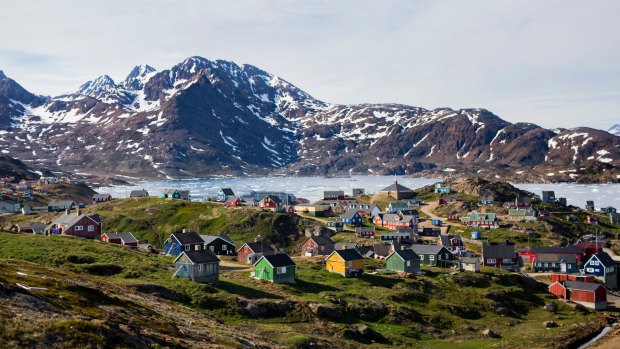
Credit: Aningaaq R. Carlsen/Visit Greenland
From Northern Lights to portable saunas.
Imagine relaxing in a sauna, with little droplets of sweat beading on your body. You dash outside to cool down but can't stay long because it's freezing. Still, you manage to spend a few minutes gazing at the thick masses of ice floating in the water.
Later that evening – this time wearing a thick bathrobe when you emerge from the sauna – you see the icebergs glistening like jewels under the starlight. And then northern lights appear – magenta-and emerald-coloured surfers catching waves across the sky.
For guests exploring East Greenland with Tasiilaq Tours – a boutique travel company run by Rasmus Poulsen – this is an average day.
"We've recently introduced a transportable sauna that we can take on backcountry tours, but otherwise we have the sauna sitting on the outskirts of Tasiilaq and the views unbelievable," Poulsen says. "You have to experience it."
Poulsen moved to Tasiilaq in 2016 after meeting his Tasiilaq-born Inuit girlfriend in Sisimiut. Today, he is one of the main tourism suppliers in the region with an Airbnb, a couple of snowmobiles, 15 dogs, a boat, and now a portable sauna.
Although it's the largest town in East Greenland, Tasiilaq can only be reached via an expedition cruise, or a helicopter or boat transfer from the settlement of Kulusuk (located on the island of the same name).
From here, the few smaller settlements in this vast region are reachable by helicopter year-round, or on boats during summer and dog sleds in winter.
THE NATIONAL PARK
Bigger, much bigger, than Texas.
Greenland's National Park is the world's largest national park, spanning an area of 972,000 square kilometres, which is only a little smaller than South Australia.
Arctic animals are the main residents in this winter wonderland, along with only about 40 people, who staff live the weather and monitoring stations and are part of Sirius Dog Sled Patrol – a military unit which is part of the Arctic command monitoring the coast line by dogsled.
Hunters from Ittoqqortoormiit, located in East Greenland around 150 kilometres from the National Park, are the only ones who have regular access to it and even so, they may only visit for up to 24 hours without a permit.
Anyone else who wants to visit one of the most isolated places in the world needs to apply to the Greenlandic government, a process that can take up to three months.
No one has visited via land for a few years but expedition cruise ships offer an easier way in.
Oceanwide Expeditions and Albatros Expeditions, among others, offer itineraries that visit the park and in these circumstances request the permits. It's not impossible for individuals, however.
Mette Barselajsen, director of Nanu Travel, a tourism information office based in Ittoqqortoormiit, says that one of their unique offerings are customised tours into the National Park.
"We provide tours, advice, and logistic support required for independent expeditions," says Barselajsen. "During the summer you can enter the national park by boat via the Scoresby Sund fjord, and in the winter entry is by dogsled.
"We can organise a trip accompanied by an Innuit hunter. The journey takes 22 days and most days travel is six to eight hours by dogsled. You sleep in a mix of cabins and tents, with our dogs there to alert you of nearby polar bears."
See albatros-expeditions.com; nanutravel.dk; oceanwide-expeditions.com
The writer travelled as a guest of Visit Greenland and Air Greenland.
FIVE THINGS THAT MAY SURPRISE YOU ABOUT GREENLAND
GREENLAND IS THE WORLD'S BIGGEST ISLAND
The total area of Greenland is 2.16 million square kilometres, and almost 80 per cent of the land mass is covered by an ice cap.
ALMOST EVERYONE LIVES ON THE COAST
The people of Greenland live predominantly on the coastline, as the rest of the country is covered by ice and snow year-round. Boats are the main form of transport
THE LONGEST ROAD IS GREENLAND IS ONLY 35 KILOMETRES IN LENGTH
Boats are the main form of transportation used by locals to get around in summer. Dog sleds are commonly used in winter.
DEEP ROOTED CULTURE
Greenland's population is 88 per cent Inuit (or a mix of Danish and Inuit) and cultural experiences are an important aspect of travel here.
GREENLAND IS AN AUTONOMOUS COUNTRY
Greenland, an autonomous nation, within the Kingdom of Denmark, has enjoyed self-rule since 2009 and has the right to self-determination with the option of independence.
THE DETAILS
FLY
Singapore Airlines operates flights from Australia cities to Singapore which connect onwards to Copenhagen five times per week. From Copenhagen, Air Greenland flies to Kangerlussuaq a minimum four times a week, and up to nine times a week in peak periods. See airgreenland.com; singaporeair.com
MORE
Sign up for the Traveller Deals newsletter
Get exclusive travel deals delivered straight to your inbox. Sign up now.